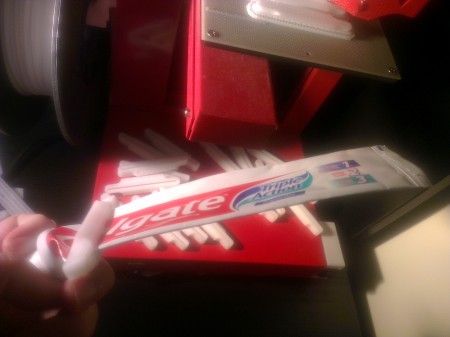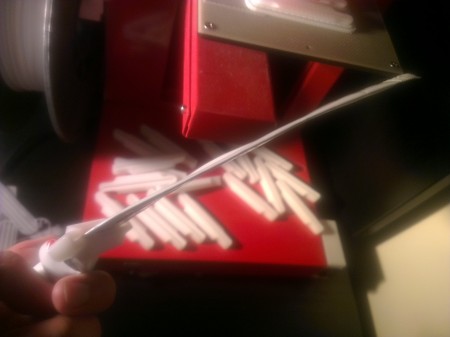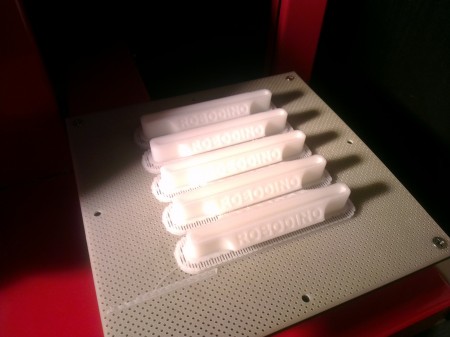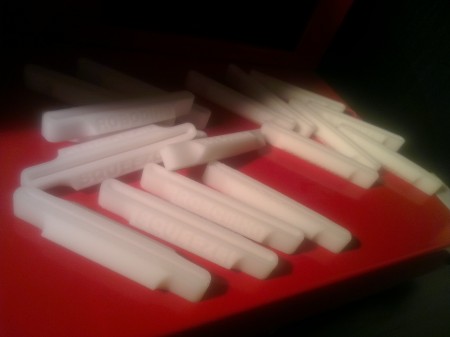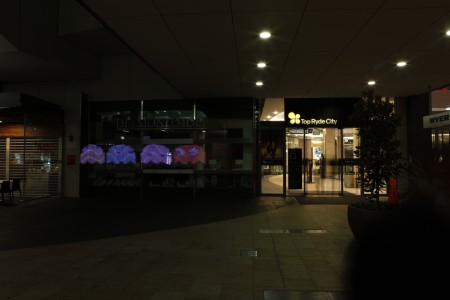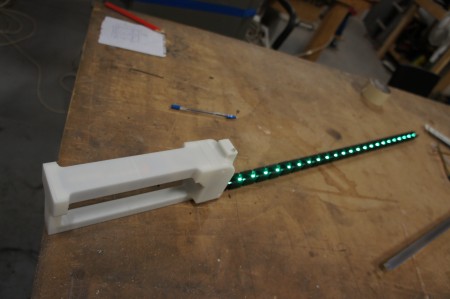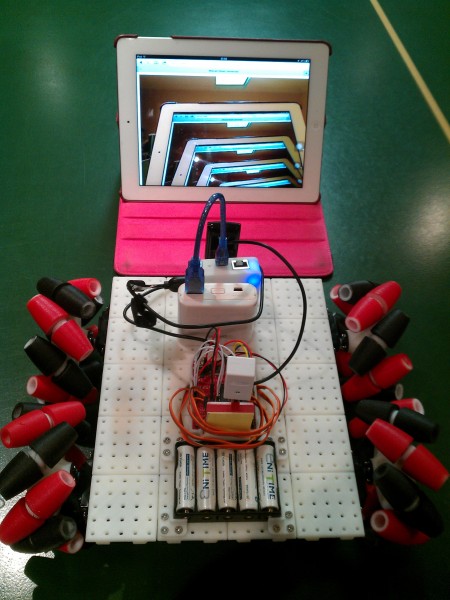Upfront disclosure : I am/was/is/might be a reseller/affiliate/enthusiastic end user of the pp3dp Up! printer. Though these connections are how I managed to get my grubby little hands on an Engineering prototype of the Up! Mini printer. Those who know me will see that the following is an unbiased opinion, or it should be obvious from all the semi-negative points.
The Up! Mini is listed on pp3dp’s blog as to be revealed at “Rapid 2012” in Atlanta on May 22, but since Australia is nicely ahead of the rest of the world I think the first unveiling was actually at CeBIT Australia 2012 by the Oceania Distributor 3D Printing Systems. Seeing the printer at an expo is one thing, getting a hands on feel is much more satisfying. I had the printer at my disposal for the weekend, apparently I’m the first outside of pp3dp to receive one of these and I really appreciate the opportunity to peek.
I’ve owned the standard Up! Since Sep 2010 when it was first released and have managed to entice a number of people with the printer (~10 Up! owners within the Sydney Hackerspace) since then. The Up! Mini is the first refresh since almost two years of a proven and reliable 3D printer design.
Photos :
Error: the communication with Picasa Web Albums didn’t go as expected. Here’s what Picasa Web Albums said:
Error 404 (Not Found)!!1
404. That’s an error.
The requested URL /data/feed/api/user/114506261366431391535/album/UpMiniPreview?kind=photo was not found on this server. That’s all we know.
Technical :
Lets have a look at the technical details :-
- “Build volume” : 1.7L aka 120mm x 120mm x 120mm
- Layer height / resolution : 0.25mm, 0.30mm, 0.35mm
- Enclosed Build Chamber
- Steel sheet metal construction
- Heated build platform
- Intelligent auto-support generation
It is clear from the design and build that the Up! Mini shares a history with the Up! One of the best features of the Up! printer compared to the competition is that it is truly plug and play and ready to print, that tradition is carried over to the Up! Mini through the use of the same software with auto-support generation. It is simply load a model and press print.
There are a few incremental design ‘improvements’ such as the heated build platform. It is now a PCB platform with a distributed heating element/track to provide for a more consistent platform temperature. I put ‘improvements’ in quotations, because while this is good in theory, I couldn’t get a decent result in my quick tests with significant warping.
Initial Thoughts :
Many people are familiar with the Up! so lets iterate through the differences and other noticeable things I noticed during my short hands-on experience. “(-)” denotes that I see it as a negative, “(+)” for those I think is a positive and (^) is like a ‘meh’.
- Fully enclosed sheet metal body
- (+) The printer looks much more professional and polished and sits well within a home or office environment without raising eyebrows.
- (-) I can’t see the print anymore! Maybe pp3dp can consider a clear/translucent front cover.
- Lack of a filament feeder
- (^) The load of pulling the filament is now up to the extruder stepper, it seems to be handling the load just fine but …
- (+) It is quieter at least with one less noise source
- (-) The power out connector is missing now, it would have been good even as an optional add-on.
- Smaller build area / volume
- (-) For me this is a minus as I’ve been craving for a larger build area for a long time. Though I am wary of large advertised build areas and keep reminding people to ask “can it really print to the full envelope?” [Hello BFB, I’m looking at you] [Though the new BFB new platform + PLA support is pretty cool]
- Linear bearings on rods vs linear slides
- PCB Heated Platform
- (+) The platform has been redesigned to be a PCB with a heated track to distribute heat more evenly, but apparently the new heat temperature is only 50 C.
- (+) The build platform slides onto the heated platform and is held in place by metal brackets. No more annoying screws or messy clips.
- (+) The new platform temperature is only 50 C makes it much more friendly to handle for the mass market. Though I do have reservations on this temperature.
- (-) Where did the temperature sensor go? Self regulating temperature you say? I don’t believe you…
- Printed Extruder Mount
- (-) In the Engineering prototype I had, the extruder mount was 3D printed and the extruder simply clips on. Whilst this seems like a good idea, the prototype had a fair bit of give in the mount affecting the print quality. Hopefully this gets fixed before production units.
- The filament spool is now mounted at the back
- (-) It might make it more neat and compact, but makes maintenance of knowing when a spool is almost finished and actually changing it out a bit trickier.
- The RRP is 995AUD, USD pricing is similar (slightly less)
- (+) Wow that is cheap/good value/awesome. Impulse buy range for a lot of people now…
Video :
Of me using the printer “out of the box”, with a couple of ‘DUH’ fails on my part thinking that I’m an experienced user and that I don’t need to follow the manual (e.g. I forgot to install the USB drivers).
http://www.youtube.com/watch?v=szUmC37N9aY
Verdict (a pretend one, a bit unfair to have a verdict on an Engineering prototype) :
The Up! Mini is obviously a consumer orientated 3D printer, with good aesthetics and the enclosure to provide a more polished professional look. The price has significantly been slashed in response to the competition, and to match it has lowered the bar slightly in my opinion. The Up! Mini is NOT an upgrade for existing Up! owners in my opinion, the name implies it is a lower end model for the price conscious consumer.
To me, it is intended to challenge the ‘Cubify’ from 3D Systems and from what I’ve seen, the Up! Mini is a winner with a lower initial cost as well as cheaper (though still relatively expensive) running costs (filament).
EDIT : If you buy an Up! from 3D Printing Systems, use my affiliate code 😉
http://store.3dprintingsystems.com/index.php?route=product/product&product_id=42&tracking=4f6ba0ffd6ee1
